Ohio is one of the leading industrial states in the United States. Its industries produce chemicals, machine parts, metal products, motor vehicles, processed foods, steel, and many other products. Ohio ranks 7th among the states in population, though it is 35th in area. Columbus is Ohio’s largest city and the state capital. Cleveland, the state’s chief industrial center, is Ohio’s second largest city.

Ohio took its name from the Iroquois word meaning something great. The Indigenous (native) Iroquois people used the word for the Ohio River, which forms the state’s southeastern and southern borders. Ohio is called the Buckeye State because of the buckeye trees that once grew plentifully on its hills and plains. Pioneers cut down many of the buckeyes to build log cabins.
In 1803, Ohio became the first state to be carved out of the Northwest Territory. Ohio later served as an important link to the West as canals, railways, and roads crossed the state. It was called the Gateway State.
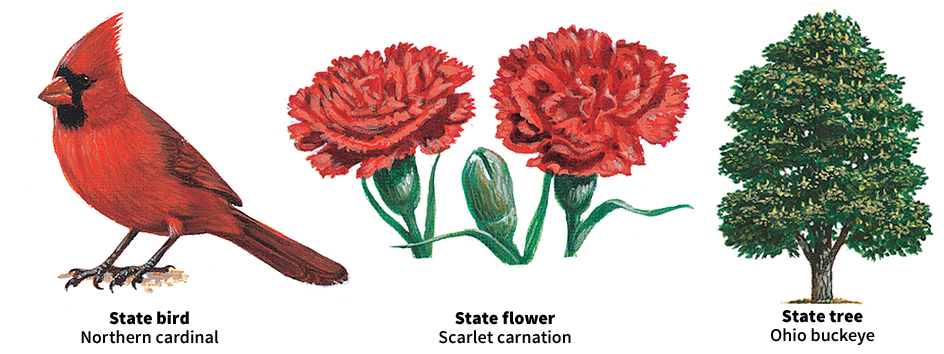
Several natural advantages helped Ohio become a great manufacturing state. Ohio has an abundant supply of water and large deposits of coal, salt, and other important minerals. Its central location, near raw materials and major markets, has helped attract many large industries. Ohio ranks high among the states in the manufacture of cars and trucks, chemicals, fabricated metal products, industrial machinery, motor vehicle parts, processed foods, and steel.
But manufacturing is only part of the Ohio economy. A majority of the state’s workers are employed in service industries, which include such activities as education, finance, government, health care, insurance, and trade. Cleveland and Columbus are important financial centers of the United States. Cleveland is among the nation’s leading health care centers. Cincinnati, Ohio’s third-largest city, is also an important center of manufacturing and trade.
Farmland covers about half of Ohio. Soil in the Till Plains area of western Ohio is especially fertile. Ohio is a major producer of corn and soybeans.
Ohio claims the title of the Mother of Presidents. Seven presidents of the United States were born in Ohio, more than in any other state except Virginia. In historical order, the presidents born in Ohio were Ulysses S. Grant, Rutherford B. Hayes, James A. Garfield, Benjamin Harrison, William McKinley, William Howard Taft, and Warren G. Harding. William Henry Harrison was living in Ohio when he became president of the United States.
Two of the nation’s most famous astronauts were born in Ohio. Neil A. Armstrong, the first person to set foot on the moon, was born in Auglaize County near Wapakoneta (see Armstrong, Neil Alden). John H. Glenn, Jr., the first American astronaut to orbit Earth, was born in Cambridge and grew up in New Concord. He was elected to the United States Senate from Ohio in 1974 (see Glenn, John Herschel, Jr.).
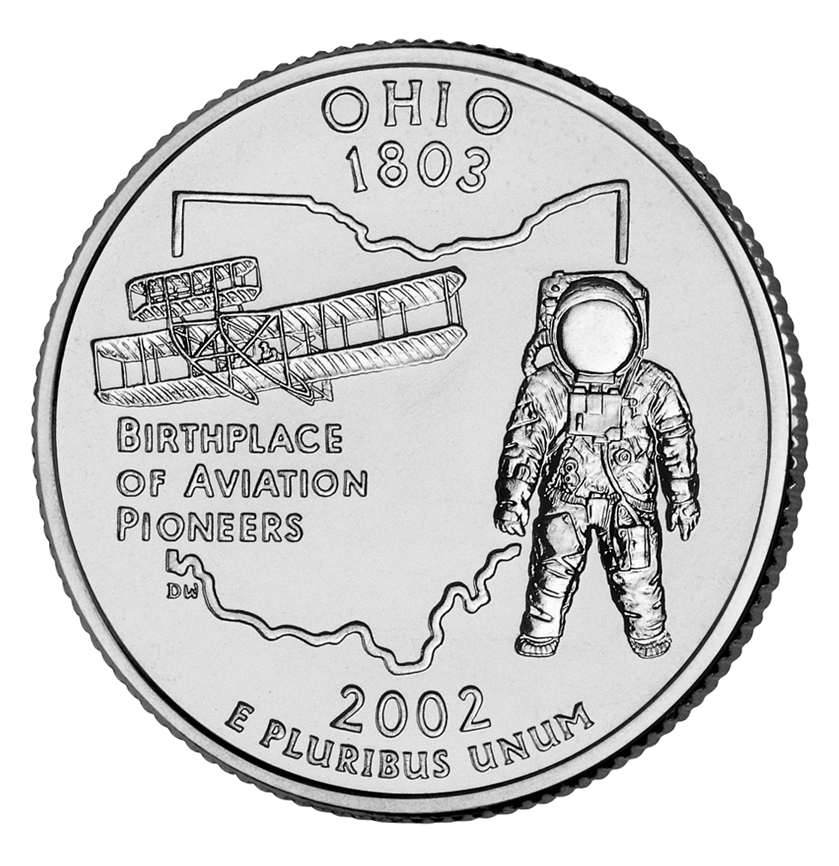
Many famous inventors also came from Ohio. Thomas A. Edison, the wizard of electricity, developed his scientific curiosity as a small boy in Milan. Orville and Wilbur Wright made test flights in their first power-driven airplane from a field near Dayton. Charles F. Kettering of Dayton developed a self-starter for automobiles. The aluminum-refining process was discovered by Charles M. Hall of Oberlin.
People
Population.
The 2020 United States census reported that Ohio had 11,799,448 people. The state’s population had increased by about 2 percent over the 2010 census figure, 11,536,504. According to the 2020 census, Ohio ranks 7th in population among the 50 states.
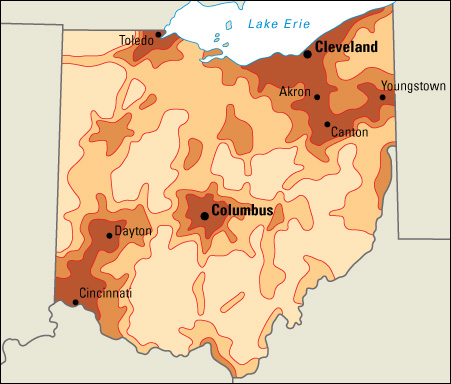
About 80 percent of Ohio’s people live in the state’s metropolitan areas. About half of the people live in the three largest metropolitan areas—Cincinnati, Cleveland, and Columbus (see Metropolitan area).
Ohio has 15 metropolitan areas. Eleven of these lie entirely within Ohio. Four metropolitan areas are partly in Ohio and partly in one or more of the bordering states of Indiana, Kentucky, Pennsylvania, and West Virginia.
Columbus, with a population of 905,748, ranks as the largest city in Ohio. Five other cities in the state have populations of more than 100,000. They are, in order of size, Cleveland, Cincinnati, Toledo, Akron, and Dayton. For more information on the cities of Ohio, see the articles listed in the Related information feature that accompanies this article.
The largest population groups in Ohio include people of English, French, German, Irish, Italian, Polish, and Scottish descent. About 13 percent of the state’s people are African Americans. Hispanics account for about 4 percent of the population. Asians account for about 3 percent.
Schools.
The first school in Ohio opened in 1773 at Schoenbrunn, near present-day New Philadelphia. It was set up for Indigenous, or Native American, children by David Zeisberger, a Moravian missionary. Ohio’s public-school system began in 1825, and public high schools were authorized in 1853. During the 1800’s, several Ohio educators wrote school textbooks that were used in public schools throughout the United States. The most famous of these educators was William H. McGuffey (see McGuffey, William H.).
Many colleges were founded in Ohio in the 1800’s. Oberlin College, established in 1833, became the first college in the United States for both men and women.
All elementary and high schools in Ohio are supervised by the State Board of Education. This board heads the state Department of Education. It consists of 11 members elected to four-year terms and eight members appointed by the governor to four-year terms. The 19 members appoint the state superintendent of public instruction. Each state college and university is supervised by a board of trustees. Ohio law requires children between the ages of 6 and 18 to attend school. For the number of students and teachers in Ohio, see Education (table: U.S. students, teachers, and school expenditures).
Libraries.
A subscription library opened at Belpre in 1795. In 1804, the famous Coonskin Library was founded at Ames (now Amesville). Pioneers bought its first books with animal skins. Many of these books have been preserved by the Ohio History Center in Columbus. The State Library of Ohio in Columbus was established in 1817 as a reference library for state officials.
The Cleveland Public Library is one of the biggest in the United States. Other large libraries in Ohio include the Public Library of Cincinnati and Hamilton County, the University of Cincinnati library system, and the Ohio State University library system in Columbus. Columbus is Ohio’s largest library center. The Rutherford B. Hayes Presidential Library in Fremont honors the 19th U.S. president. It opened in 1916 and was the nation’s first presidential library. The Cincinnati History Library and Archives highlights early Ohio and metropolitan Cincinnati.
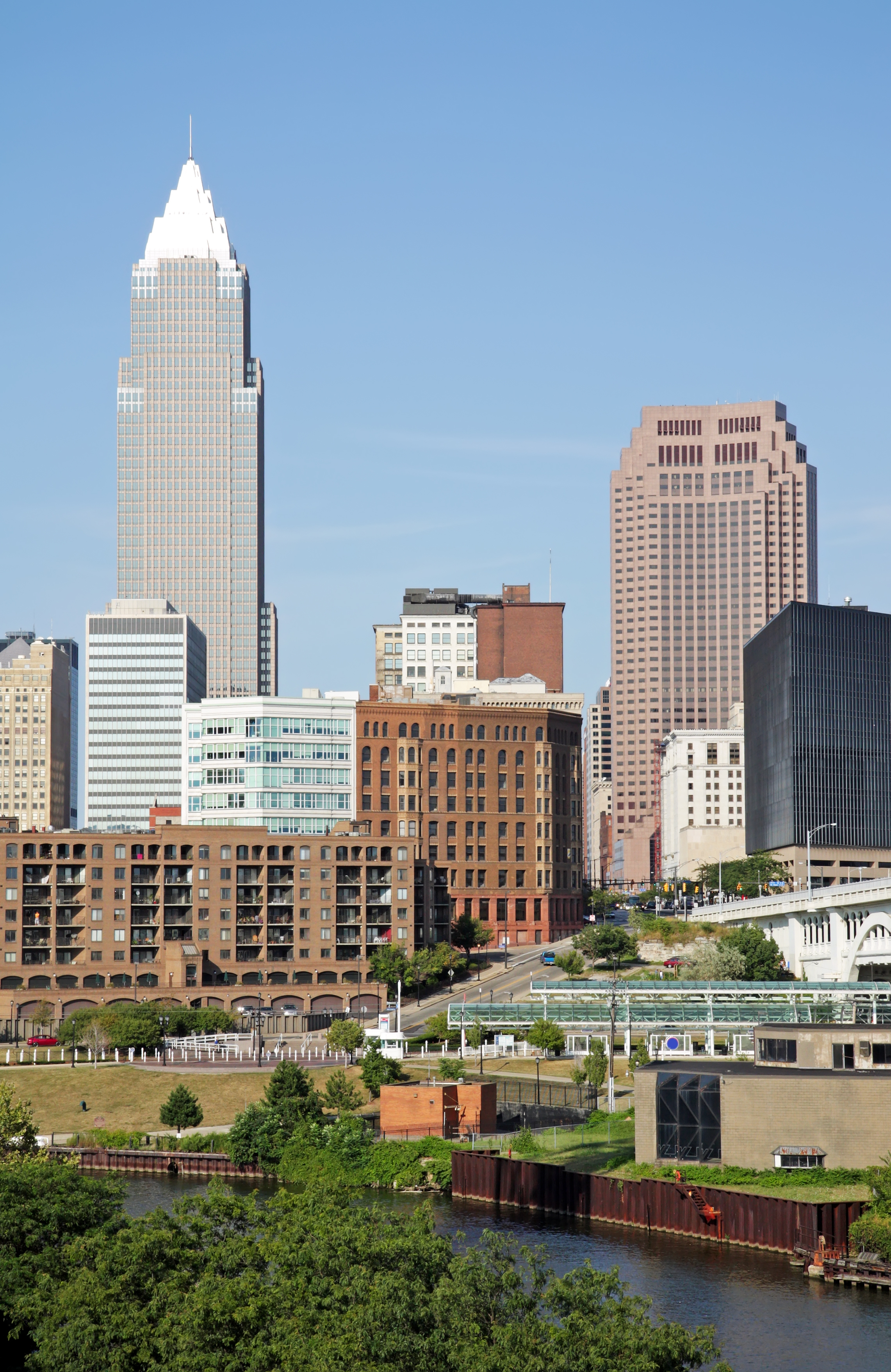
Museums.
The Cleveland Museum of Art, the Cincinnati Art Museum, and the Toledo Museum of Art all own renowned collections of art from many different periods and cultures. The Taft Museum of Art in Cincinnati displays paintings and Chinese ceramics. The National Museum of the United States Air Force at Wright-Patterson Air Force Base near Dayton exhibits old and modern airplanes. Exhibits at the Pro Football Hall of Fame, in Canton, display items from the history of professional football. The Rock and Roll Hall of Fame and Museum in Cleveland has displays and interactive exhibits about the history of rock music (see Rock and Roll Hall of Fame and Museum). 
Visitor’s guide
Ohio has hundreds of historical, recreational, and scenic attractions. Historical points of interest include huge Indigenous burial mounds and forts that date back to prehistoric times.
The 2,500 lakes and 44,000 miles (70,800 kilometers) of rivers and streams in Ohio provide many opportunities for boating, fishing, and swimming. Lake Erie is a major tourist and recreational attraction. Hunters shoot deer, ducks, and rabbits in the state’s woods and on the rolling plains. Many vacationers enjoy hiking in the hilly eastern section of Ohio, which has some of the state’s most beautiful scenery.
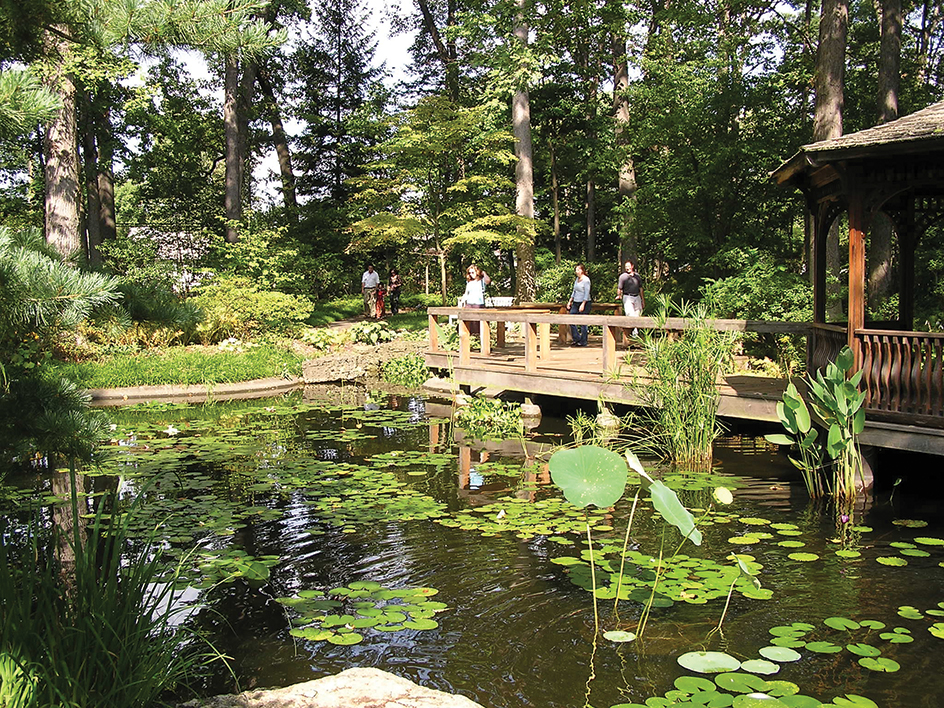
Two historical plays performed outdoors rank among Ohio’s most popular annual events. Tecumseh! (1973), a drama about the famous Shawnee leader, is held near Chillicothe. Trumpet in the Land (1970), which concerns Ohio’s first permanent white settlement, is performed near New Philadelphia. Both plays run during the summer.
Land and climate
Land regions.
Several glaciers moved down from the north thousands of years ago, during the Pleistocene Epoch, which ended about 11,500 years ago. They covered all of what is now Ohio except the southeastern part. These separate glacial movements helped create the state’s four main land regions. These four regions are (1) the Great Lakes Plains, (2) the Till Plains, (3) the Appalachian Plateau, and (4) the Bluegrass Region.


The Great Lakes Plains
of northern Ohio form part of the fertile lowland that lies along much of the Great Lakes. In Ohio, these plains make up a narrow strip of land that borders Lake Erie. The region is 5 to 10 miles (8 to 16 kilometers) wide in the east, and broadens to more than 50 miles (80 kilometers) in the Maumee Valley to the west. A few low, sandy ridges along the Lake Erie shore break the flatness of the plains. A wide variety of crops, especially fruits and vegetables, grows in the region’s fertile soil. The region is one of the busiest manufacturing, shipping, trading, and recreational areas in the United States. It includes many lake ports and large industrial cities. The most heavily populated part of Ohio, the Cleveland metropolitan area, is in the Great Lakes Plains region. See Great Lakes; Lake Erie.
The Till Plains
are the easternmost part of the rich midwestern Corn Belt, which stretches westward from Ohio. This region ranks among the most fertile farming areas in the country.
Some hills dot the gently rolling plains, which lie in most of western Ohio. One of them, Campbell Hill in Logan County, rises 1,550 feet (472 meters) and is the highest point in Ohio. From there, the land gradually slopes downward to the southwestern corner of the state in Hamilton County. This area, 433 feet (132 meters) above sea level, is Ohio’s lowest point. Farmers of the Till Plains produce grain, soybeans, and livestock. The area has many industrial cities where a wide variety of products is manufactured. It also includes Columbus, the State Capital.
The Appalachian Plateau
includes almost all the eastern half of Ohio. This highland extends eastward into Pennsylvania and West Virginia. The southern two-thirds of the region was not covered by glaciers. As a result, this section is the most rugged part of the state, with steep hills and valleys. Most of the soil is thin and not fertile. The northern third of the Appalachian Plateau has rolling hills and valleys, and has less fertile soil than that of the Till Plains.
The rugged Appalachian Plateau has some of Ohio’s most beautiful scenery, including the state’s largest forests and some waterfalls. It also has Ohio’s richest mineral deposits—clay, coal, natural gas, oil, and salt. A few of its cities are important manufacturing centers.
The Bluegrass Region,
Ohio’s smallest land region, is an extension of the Bluegrass Region of Kentucky. This triangular area in southern Ohio has both hilly and gently rolling land. The hills of the Bluegrass Region have thin, less fertile soil.
Shoreline
of Ohio stretches for 312 miles (502 kilometers) along Lake Erie, from Conneaut in the east to Toledo in the west. It includes 53 miles (85 kilometers) along Sandusky Bay, and 66 miles (106 kilometers) along offshore islands. The eastern half of the shoreline consists of clay bluffs about 10 to 18 feet (3 to 5 meters) high. The western half has beaches of clay or sand. Many harbors indent the shoreline. Two of the busy lake ports lie on large bays—Toledo on Maumee Bay, and Sandusky on Sandusky Bay. North and northwest of Sandusky in Lake Erie are some small islands. The largest ones, Kelleys and North, Middle, and South Bass islands, are used chiefly as recreation areas.
Rivers and lakes.
Ohio has more than 44,000 miles (70,800 kilometers) of rivers and streams. They flow either south into the Ohio River or north into Lake Erie. A series of low hills separates the two groups of rivers. This divide lies approximately along the southern boundary of the Great Lakes Plains and extends into Indiana. Except for the Maumee River, all the longer, wider rivers flow into the Ohio River. They drain about 70 percent of the state.
The Ohio River, one of the chief rivers of North America, flows more than 450 miles (724 kilometers) along Ohio’s southern and southeastern borders. The northern bank of the river forms the state boundary. Many bluffs from 200 to 500 feet (61 to 150 meters) high rise along the river, which winds through a valley less than 2 miles (3 kilometers) wide. See Ohio River.
The Ohio River’s longest tributary in Ohio is the Scioto River, which is 237 miles (381 kilometers) long. Other rivers flowing into the Ohio include the Hocking, Little Miami, Great Miami, and Muskingum. The largest rivers that flow into Lake Erie are the Cuyahoga, Grand, Huron, Maumee, Portage, Sandusky, and Vermilion. Some underground streams in Ohio have formed caverns, such as Seven Caves near Bainbridge and Ohio Caverns near West Liberty. Many swift streams in northeastern Ohio have rapids and waterfalls.
Ohio’s lake waters include 3,500 square miles (9,065 square kilometers) of Lake Erie. The International Line between the United States and Canada runs through Lake Erie about 20 miles (32 kilometers) north of the Ohio shore. The state has more than 2,500 lakes larger than 2 acres (0.8 hectare). Over 20 of them are natural lakes with an area of 40 acres (16 hectares) or more. These lakes were formed by the ancient glaciers. Ohio also has more than 180 artificially created lakes that cover at least 40 acres (16 hectares) each.
Several lakes were created in Ohio during the 1830’s and 1840’s to feed water into two canals. These canals were the Ohio and Erie Canal, between Cleveland and Portsmouth, and the Miami and Erie Canal, between Toledo and Cincinnati. They were Ohio’s chief means of transportation until the coming of the railroads in the 1840’s. The largest lake in Ohio is 12,700-acre (5,140-hectare) Grand Lake in the west-central part of the state. It was created during the 1840’s by damming two nearby creeks to provide water for the Miami and Erie Canal. Other large artificially created lakes include Berlin, Indian, Mosquito Creek, and Senecaville lakes.
Plant and animal life.
Forests cover about a fourth of Ohio. Most of the state’s trees are hardwoods. They include beeches, black walnuts, hickories, maples, sycamores, red and white oaks, white ashes, white elms, and yellow-poplars. Among the common shrubs found in Ohio are azalea, dogwood, hawthorn, sumac, and viburnum. The state’s wildflowers include anemones, blazing stars, blue sages, Indian pipes, lilies, saxifrages, toothworts, and wild indigos.
Ohio has few large wild animals. Only white-tailed deer are plentiful. Smaller wild animals include minks, muskrats, opossums, rabbits, raccoons, red foxes, squirrels, skunks, and woodchucks. Among Ohio’s songbirds are blackbirds, brown thrashers, cardinals, chickadees, and wrens. Bald eagles and various shore birds live along Lake Erie. Game birds include ducks, geese, pheasants, quail, ruffed grouse, and wild turkeys. Fish living in the state’s waters include bass, bluegills, catfish, muskellunge, perch, pike, and walleye.
Climate.
Ohio has cold winters and warm, humid summers, with an average annual temperature of 51 °F (11 °C). The average January temperature is 27 °F (–3 °C), and the July temperature averages 73 °F (23 °C). Ohio’s lowest recorded temperature, –39 °F (–39 °C), occurred at Milligan, near New Lexington, on Feb. 10, 1899. The highest recorded temperature was 113 °F (45 °C) near Gallipolis on July 21, 1934. 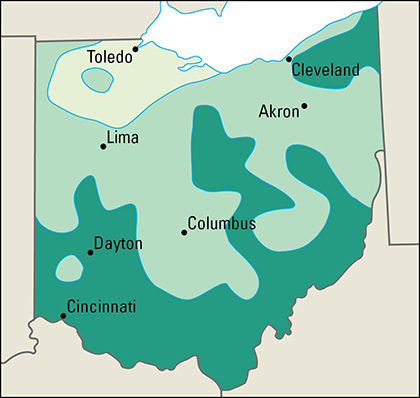
Ohio’s annual precipitation averages 40 inches (102 centimeters). The wettest area is in the southwest, where Cincinnati’s yearly precipitation is 42 inches (107 centimeters). The driest part of Ohio lies along Lake Erie between Sandusky and Toledo. It gets 33 inches (84 centimeters) of precipitation a year. Snowfall increases from west to east, and from south to north. Northeastern Ohio receives about 100 inches (254 centimeters) of snow annually and has several ski areas. Southwestern Ohio receives about 20 inches (51 centimeters).
Economy
In the heart of the industrial region of the northeastern United States, Ohio has long been known as an important manufacturing center. Ohio’s manufacturing industry is characterized by the wide variety of goods produced. The manufacture of machinery, motor vehicles, plastics, processed foods, soap, steel, and tires are all important businesses in Ohio.
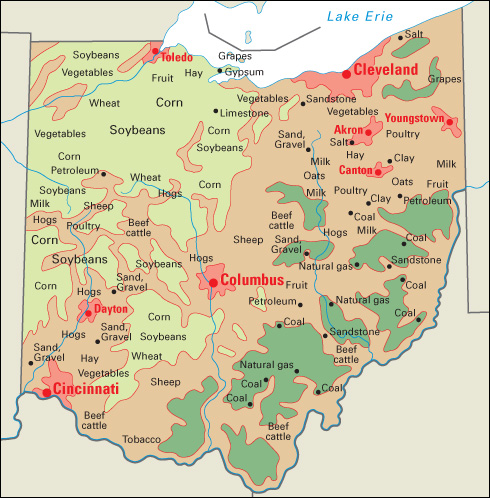
Service industries, taken together, account for the largest portion of Ohio’s gross domestic product—the total value of goods and services produced annually. Finance, insurance, and real estate is the state’s leading service industry group. Coal and petroleum are leading mined products. Corn and soybeans rank as Ohio’s most valuable agricultural products.
Natural resources.
Fertile soils and valuable minerals are Ohio’s most important natural resources.
Soil.
Fertile soils deposited by ancient glaciers are found in all parts of Ohio except the southeast. Many layers of these soils are several feet deep. Materials in the various kinds of soils include limestone, sandstone, and shale. The soil is less fertile in the southeastern part of the state, which was not covered by glaciers during the most recent ice age, which ended about 11,500 years ago.
Minerals.
Coal and petroleum are important mined products. Coal is primarily mined in eastern and southeastern Ohio. Oil and natural gas are found in eastern Ohio. The state also contains huge reserves of rock salt and salt water. The state could supply the United States with all the salt it needs for thousands of years. Most of the salt lies in deep rock-salt beds in northeastern Ohio. Other mined products in the state include large deposits of cement, clays, limestone and dolomite, sand and gravel, and sandstone.
Service industries,
as a group, account for the largest portion of Ohio’s gross domestic product and employ more people than any other type of industry. Most of the service industries are concentrated in the state’s metropolitan areas.
Finance, insurance, and real estate is important to Ohio’s economy. Most of Ohio’s largest banks are based in Cleveland and Columbus. Cleveland is the headquarters of the Fourth Federal Reserve District Bank, one of 12 federal banks established by Congress. Cincinnati is also the home of several large financial companies, including Fifth Third Bancorp. Several large insurance companies, including Nationwide Mutual Insurance Company & Affiliated Companies and Progressive Casualty Insurance Company, have headquarters in Ohio. 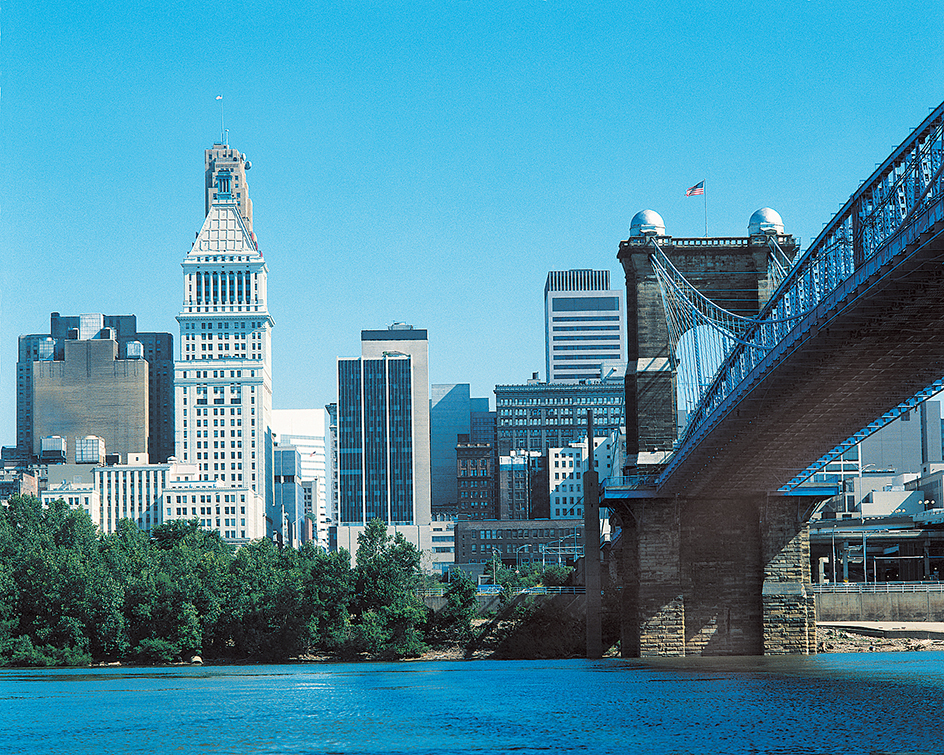
Columbus, the state capital, is the center of government activities. Cleveland is a leading center of health care in the United States. Many hotels, restaurants, and retail trade establishments operate in the Cincinnati, Cleveland, and Columbus areas. The ports of Cincinnati and Toledo handle much wholesale trade. Several large shipping companies lie along Lake Erie and the Ohio River. Wright-Patterson Air Force Base lies near Dayton.
Many large companies are headquartered in Ohio. The Cincinnati area is the home of several major retail companies, including Macy’s, Inc. and the Kroger Co. Wendy’s, a leading restaurant chain, is headquartered in Dublin. Columbus is the home of Battelle Memorial Institute, one of the world’s largest private research organizations (see Battelle Memorial Institute). Roadway Express, a major trucking company, is headquartered in Akron.
Manufacturing.
Ohio ranks high among the states in total value added by manufacture. Akron, Cincinnati, Cleveland, Columbus, Dayton, and Toledo are among the leading manufacturing cities.
Transportation equipment is one of Ohio’s leading manufactured products. The most important types of transportation equipment made in Ohio are motor vehicles and motor vehicle parts. Ohio is a leading producer of both cars and trucks. Motor vehicle parts come from the Cincinnati, Cleveland, Dayton, Toledo, and Warren areas. Ohio also manufactures airplanes and aircraft parts. 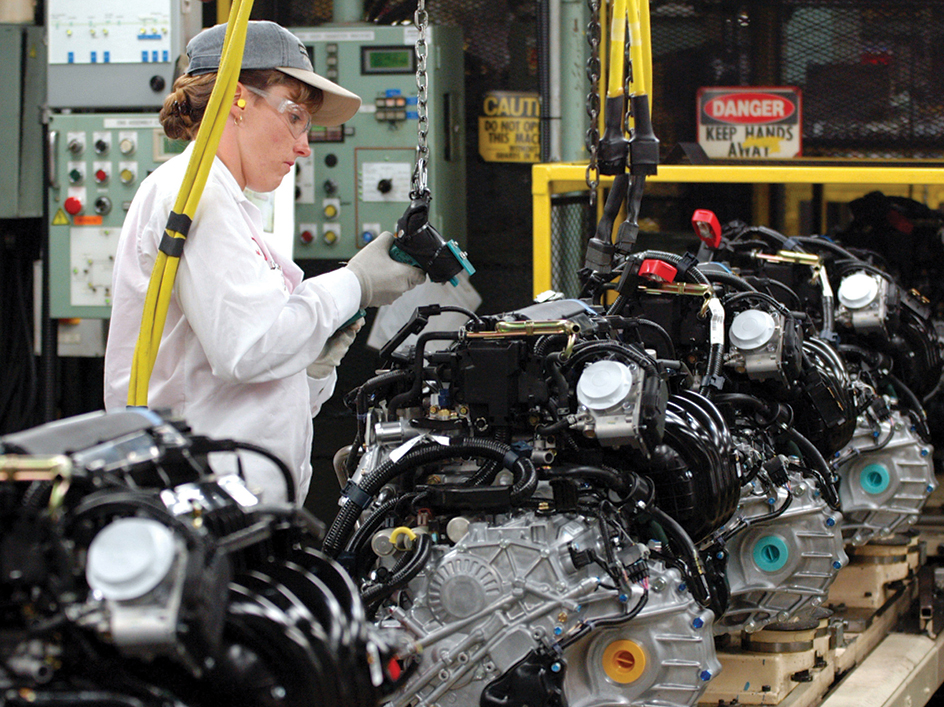
Food products are also important. The Canton, Cincinnati, Cleveland, and Columbus areas the main food-processing centers. Solon makes frozen dinners. One of the world’s largest yogurt manufacturing plants is in Minster. Napoleon has a large soup factory. A factory at Wellston produces frozen pizzas.
Ohio is a leading U.S. producer of both fabricated metal and primary metal products. Machine shop products are the leading fabricated metal product. The Cleveland area leads Ohio in fabricated metal production. Ohio ranks second nationally in raw steel production. Only Indiana produces more steel. The largest steelmaking centers are in the Canton, Cleveland, Middletown, and Warren areas. Cincinnati, Cleveland, and other cities have aluminum foundries.
Chemicals, glass products, machinery, and plastics and rubber products are also produced in Ohio. Ohio’s leading chemical products include industrial chemicals, paints and varnishes, and soaps and cleansers. The Procter & Gamble Company, a major manufacturer of soaps and cosmetics and many other products, is based in Cincinnati. Toledo and other cities in Ohio make glass. Plentiful deposits of sand and natural gas, which are used in glassmaking, helped establish the glassmaking industry in the state. Ohio’s major machinery products include heating and cooling equipment and machine tools and machine tool parts. Cincinnati, Cleveland, and Dayton are the chief centers of machinery production. Factories in Akron, Dayton, and Findlay make such rubber products as hoses and tires. Goodyear Tire & Rubber Company, an important manufacturer of tires and other rubber products, has its headquarters in Akron. Many cities in Ohio produce plastic products.
Agriculture.
Farms cover about half of Ohio’s land area. Crops account for over half of the state’s agricultural income.
Field crops provide much of Ohio’s farming income. Corn and soybeans are the state’s leading farm products. Ohio ranks among the leading producers of both corn and soybeans. Farmers grow these two crops in nearly all parts of the state, especially in the Till Plains region. Other field crops raised in the state include hay and wheat.
Ohio has been an important fruit-producing state since pioneer days, when Johnny Appleseed roamed the countryside planting apple seeds (see Appleseed, Johnny). In addition to apples, Ohio farmers produce grapes, peaches, and strawberries. Vineyards on the plains along Lake Erie and on the offshore islands grow grapes. Warm lake winds protect the grapes from frosts in late spring and early autumn.
Ohio growers produce large crops of bell peppers, cabbages, cucumbers, potatoes, pumpkins, squash, sweet corn, and tomatoes. The rich soils of the Great Lakes Plains and the warmer lowlands along the Ohio River are especially good for growing vegetables. During the cold season, vegetables are grown in heated glass shelters called hothouses. The Great Lakes Plains and Till Plains also have tree nurseries and flower greenhouses.
Milk is the leading livestock product in Ohio. The state’s leading dairy-farming areas include Columbiana, Holmes, Stark, Tuscarawas, and Wayne counties in the northeast, and Mercer County in the west. The state ranks as a leading producer of cheese and ice cream.
Many farmers in Ohio raise beef cattle. Ohio also ranks as a major hog-producing state. Farmers in the Miami River Valley developed the famous Poland China hog during the 1800’s. A monument to the Poland China breed stands near Monroe. Farmers also raise sheep for both mutton and wool, chiefly in the central part of the state.
Ohio is one of the leading states in egg production. Most of the egg-producing poultry farms are in the west-central part of the state. Ohio poultry farmers also raise turkeys and broilers (young, tender chickens).
Mining.
Coal is a leading source of Ohio’s mining income. The state’s great fields of bituminous (soft) coal lie mainly in the east and southeast. Harrison and Monroe counties produce the most coal. The fields there form part of the great Appalachian coal fields that include parts of Pennsylvania and West Virginia.
Natural gas is also a valuable mined product in Ohio. The eastern part of the state is the leading area for natural gas production. Gas is pumped from the wells to businesses and homes, where it is used mainly for heating.
Ohio is a leader in the production of dimension sandstone, which is cut in blocks. Sandstone is taken chiefly from quarries in eastern and northern Ohio. The best-known variety of sandstone, Berea or grit, comes from Lorain County. Ohio is also a leading producer of common clay. This clay is used in such products as bricks and tile, cement, pottery, and stoneware.
Ohio is an important producer of limestone and also a leader in the production of lime, which is made from limestone. Other uses of limestone include the manufacture of cement, chemicals, fertilizers, and steel.
Ohio’s oldest mining industry is the production of salt, and the state is one of the nation’s leading salt producers. One of the deepest salt mines in the United States is near Fairport Harbor, northeast of Cleveland. Petroleum is mined in several parts of eastern Ohio. Sand and gravel are produced throughout the state.
Electric power and utilities.
Ohio’s largest utility companies are American Electric Power of Columbus and FirstEnergy Corp. of Akron. Plants that burn coal or natural gas provide over half of the electric power generated in Ohio. Nuclear plants produce most of the remaining power.
Transportation.
Ohio is a transportation link between the eastern and western United States. Cross-country railways and roads began going westward through the state during the 1800’s.
The first east-west roads in Ohio were the natural trails that followed the sandy ridges along Lake Erie. Later roads, paved with logs, followed Indigenous trails. The historic Zane’s Trace, built for the federal government by Ebenezer Zane, opened in 1797. It ran between what is now Wheeling, West Virginia, and Maysville, Kentucky, through the present-day Ohio cities of Zanesville, Lancaster, and Chillicothe. Maysville was then the northern end of the road to New Orleans. During the early 1800’s, the National (Cumberland) Road became an important link between the East and the West (see National Road).
Today, Ohio has an extensive system of roads. Many multilane highways and expressways cross the state. The Ohio Turnpike runs across northern Ohio between the Pennsylvania and Indiana borders. Freight railroads operate on thousands of miles of rail line in the state.
Cleveland Hopkins International Airport is Ohio’s busiest airport. Major airports also serve the Akron- Canton, Columbus, Dayton, and Toledo areas. The largest airport serving the Cincinnati area lies in nearby Boone County, Kentucky.
The Great Lakes and the St. Lawrence Seaway connect Ohio with the Atlantic Ocean. Ice closes this passage in January and February. The Great Lakes also link Ohio with the north-central states and Canada. Another major waterway, the Ohio River, connects the state with the Mississippi River and the Gulf of Mexico. The entire length of this waterway is navigable all year.
Communication.
The first newspaper published north and west of the Ohio River, the Centinel of the North-Western Territory, was founded in Cincinnati in 1793. The nation’s first antislavery newspaper, the Philanthropist, began publication in Mount Pleasant in 1817. Today, Ohio’s largest daily newspapers include the Akron Beacon Journal, The Blade of Toledo, The Cincinnati Enquirer, The Columbus Dispatch, the Dayton Daily News, The Plain Dealer of Cleveland, and The Repository of Canton.
Government
Constitution
of Ohio, the second in the state’s history, was adopted in 1851. Ohioans adopted their first constitution in 1802. An amendment may be proposed by (1) the state legislature, (2) a petition signed by 10 percent of the voters, or (3) a constitutional convention. A convention may be called if it is approved by two-thirds of each house of the legislature and by a majority of the voters. Ohioans also vote every 20 years as to whether they wish to call a constitutional convention. Amendments to the Constitution must be approved by a majority of the people voting on them in an election.
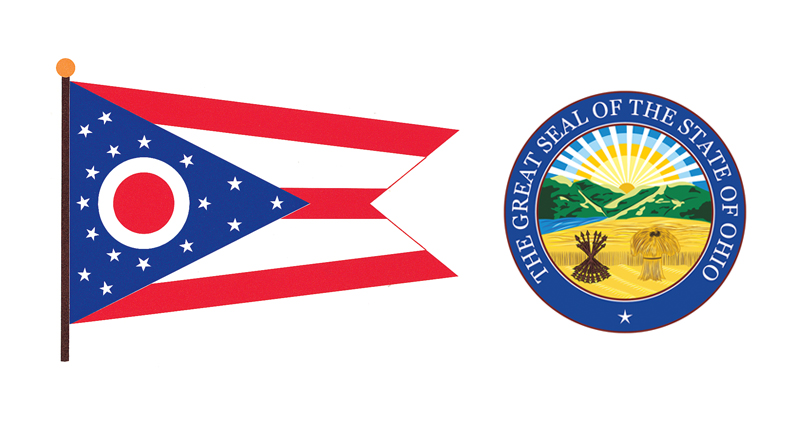
Executive.
The governor and lieutenant governor of Ohio are elected to four-year terms. They can serve an unlimited number of terms, but not more than two terms in succession. The governor has the power to appoint the heads of many of the state’s administrative departments and agencies and also the trustees of state-supported universities and institutions. Some appointments of the governor must be approved by the state Senate.
Voters also elect the secretary of state, attorney general, treasurer, and auditor. These officials may not serve more than two terms in succession.
Legislature,
called the General Assembly, consists of a 33-member Senate and a 99-member House of Representatives. Voters in each of Ohio’s 33 senatorial districts elect one senator. Senators serve four-year terms and may not serve more than two terms in succession. Voters in the state’s 99 representative districts elect one representative. Representatives serve two-year terms and may not serve more than four terms in succession. Regular legislative sessions begin on the first Monday of January in odd-numbered years and have no time limit. 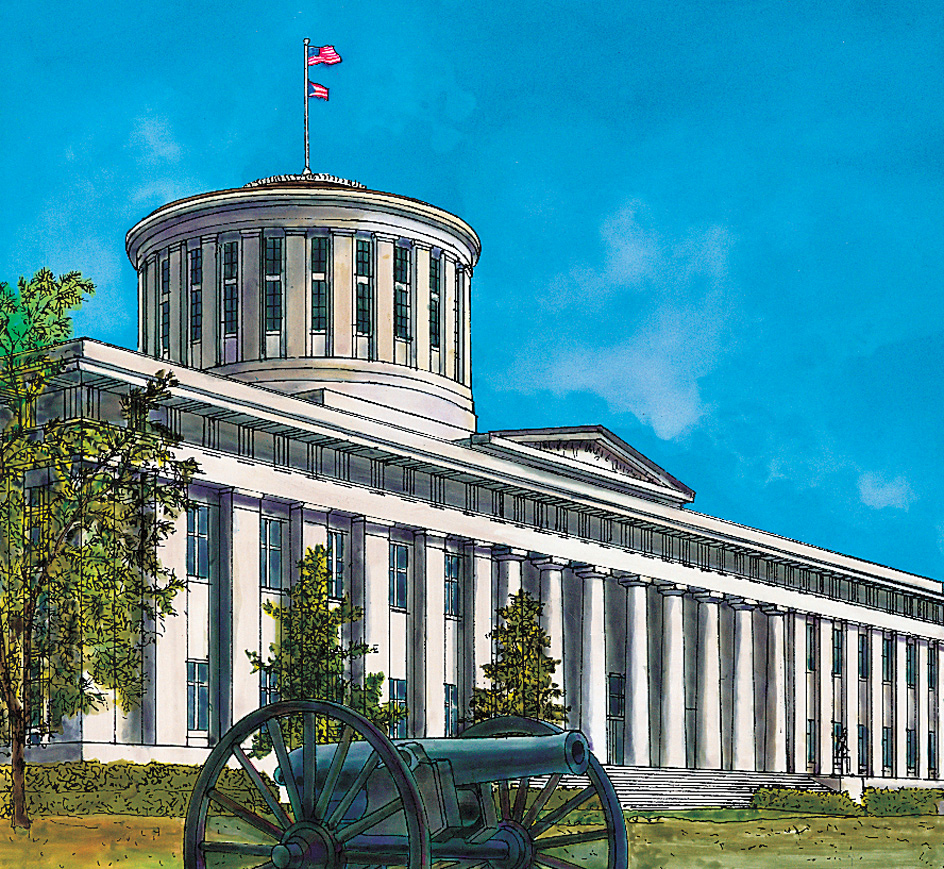
A 1903 amendment to the state Constitution required that each county have at least one representative, regardless of its population. In 1964, the Supreme Court of the United States ruled this amendment unconstitutional. In 1965, Ohio’s governor, the state auditor, and the secretary of state drew up a reapportionment (redivision) plan for the Senate and House of Representatives. They set up single-member legislative districts that were as equal in population as possible. A special three-judge federal district court approved the plan for use until a permanent plan could be drawn. The Supreme Court of the United States approved the federal district court’s decision. In 1967, the Constitution was amended to provide for a permanent reapportionment plan.
Courts.
The highest appeals court in Ohio is the Supreme Court. It has a chief justice and six other justices, all of whom are elected to six-year terms. Ohio also has 12 courts of appeals. The court of Cuyahoga County has 12 judges. The other districts in Ohio have from 4 to 8 judges each.
The highest trial courts in Ohio are the courts of common pleas. Each of the state’s 88 counties has one such court. These courts have varying numbers of judges, all of whom are elected to six-year terms. Other courts in Ohio include county, juvenile, municipal, mayor, and probate courts.
Local government.
Ohio has 88 counties. All of the counties except Cuyahoga and Summit are governed by an elected three-member board of commissioners. Cuyahoga and Summit counties are each governed by an elected county executive and an 11-member council. By law, counties may have home rule—that is, a county may adopt its own charter. But only Cuyahoga County and Summit County have done so.
Most Ohio cities have more than 5,000 people. Villages generally have populations of less than 5,000. Officially, Ohio has no towns. Ohio law allows cities and villages to adopt home rule. The home-rule cities and villages have mayor-council, council-manager, or commission governments. In 1913, Dayton became the nation’s first large city to adopt council-manager government. Most of Ohio’s cities and villages have a mayor-council government.
Revenue.
Taxes account for about two-fifths of the state government’s general revenue (income). Most of the rest comes from federal grants and other U.S. government programs.
A general sales tax and a personal income tax are the leading sources of tax revenue. Other state taxes include those on corporate activity, motor fuels, motor vehicle licenses, and tobacco products. Other revenue comes from charges for government services and from a state lottery.
Politics.
Both the Democratic and Republican parties have much strength in Ohio. The Democratic Party is strongest in Cleveland and other metropolitan areas in northeastern Ohio. The Republican Party is dominant in most rural areas and is also strong in the Cincinnati and Columbus metropolitan areas. Since the end of World War II in 1945, Republican candidates have held an edge in elections for Ohio governor.
Ohio is often called a barometer state in national politics. That is, the political views of Ohioans frequently indicate those of most Americans. For example, the winning presidential candidates have won Ohio’s electoral votes in a great majority of presidential elections since 1804.
History
Early days.
Thousands of years ago, prehistoric people lived in what is now Ohio. They were the ancestors of peoples called Mound Builders, some of whom had high forms of civilization. The Mound Builders left more than 6,000 burial mounds, forts, and other earthworks throughout the Ohio region. The Mound Builders included the Adena and Hopewell peoples, who lived there from about 600 B.C. to about A.D. 500. See Mound Builders.
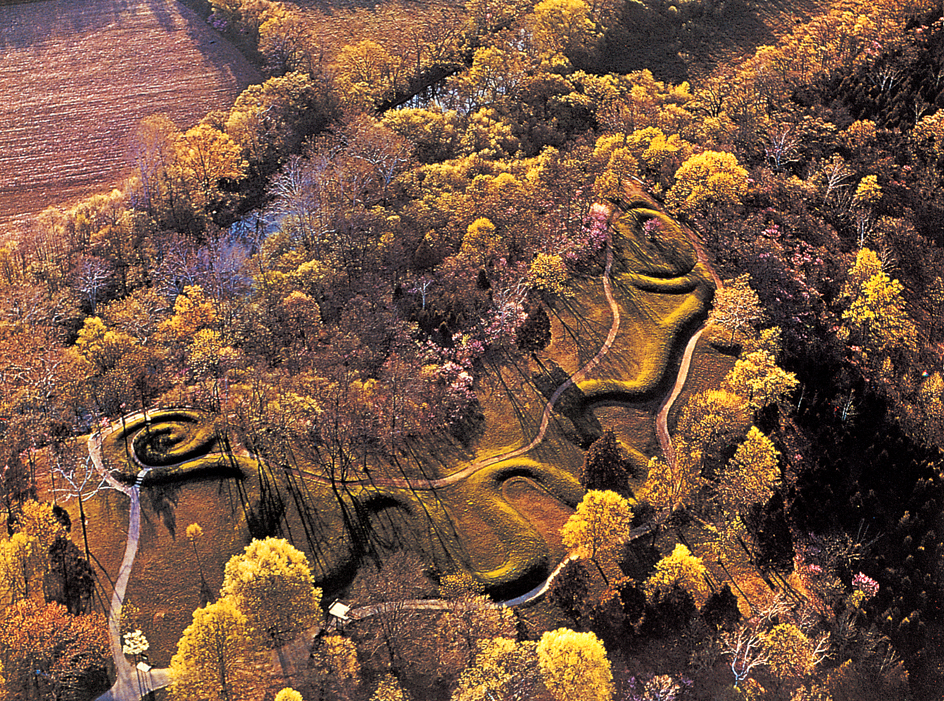
When the early white settlers arrived, several groups of Indigenous (native) people, also called Native Americans or American Indians, lived in the Ohio region. These groups included the Delaware, Miami, Shawnee, and Wyandot, or Huron.
Exploration and settlement.
The French explorer René-Robert Cavelier, Sieur de La Salle, was probably the first white person to reach present-day Ohio. He is believed to have visited the region about 1670. The French based their claim to the entire Northwest on La Salle’s explorations. But the British claimed all the territory extending inland from their Atlantic colonies. In 1750, the Ohio Company of Virginia sent Christopher Gist to explore the upper Ohio River Valley. This company, organized in 1747, was made up of English people and Virginians who planned to colonize the Ohio region. See Gist, Christopher; La Salle, René-Robert Cavelier, Sieur de; Ohio Company (The first Ohio Company).
The dispute between the United Kingdom and France over territory in North America, including the Ohio region, led to the French and Indian War (1754-1763). In the peace treaty of 1763, France gave the United Kingdom most of its lands east of the Mississippi River. Pontiac, an Ottawa chief believed to have been born in Ohio, started an Indigenous rebellion against the British in 1763 after the peace treaty was signed. See French and Indian wars; Pontiac.
Fighting during the American Revolution (1775-1783) forced a Moravian mission settlement named Schoenbrunn, near present-day New Philadelphia, to close down. The settlement, founded in 1772 by David Zeisberger, was abandoned in 1776. In 1780, George Rogers Clark defeated Shawnee allies of the British in the Battle of Piqua, near present-day Springfield. Clark’s campaigns in the Northwest helped the United States claim the region in the 1783 treaty that ended the war.
The region, including Ohio, became the Northwest Territory in 1787. The Northwest Ordinance of 1787 provided for the eventual statehood of Ohio and other divisions of the territory. That year, the Ohio Company of Associates bought land northwest of the Ohio River in the Muskingum River Valley. Members of this company came from New England. On April 7, 1788, the company founded Marietta, the first permanent white settlement in Ohio. Rufus Putnam, a general during the American Revolution, was superintendent of the colony. Marietta became the first capital of the Northwest Territory in July 1788. Soon other communities developed along the Ohio River. Many settlers were Revolutionary War veterans who received land in payment for their military service. See Northwest Territory; Ohio Company (The second Ohio Company); Putnam, Rufus. 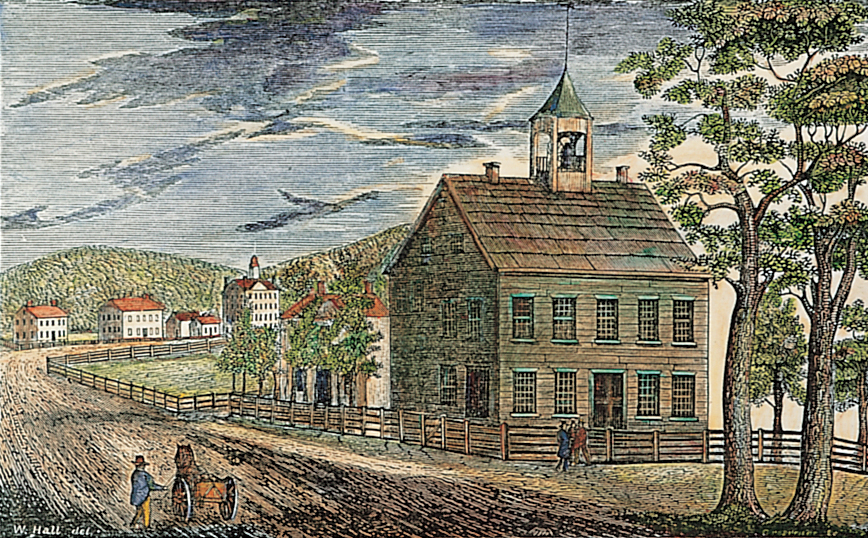
For several years, Indigenous people resisted the expansion of white settlements. Several raids were led by Little Turtle, a chief of the Miami people. In 1794, General Anthony Wayne defeated a confederacy of Indigenous groups near present-day Toledo in the Battle of Fallen Timbers. The next year, in the Treaty of Greenville, Indigenous leaders ceded the United States about two-thirds of what is now Ohio. The Indigenous people accepted the treaty largely through the influence of Tarhe, or Crane, a Wyandot chief. With peace restored, more and more settlers poured into the region. Many settlements were founded in the valleys of rivers flowing into the Ohio. Pioneers also settled in northeastern Ohio in the area called the Western Reserve (see Western Reserve). 
In 1800, Congress passed the Division Act. This legislation created the Indiana Territory out of the western part of the Northwest Territory. Chillicothe became the capital of the eastern part, which continued to be called the Northwest Territory.
Statehood.
Preparation for Ohio statehood began in November 1802, when a convention in Chillicothe drew up the state’s first constitution. Ohio became the 17th state on March 1, 1803, when the first state legislature met. Edward Tiffin, a Democratic-Republican, was the first governor. Ohio’s population was about 70,000. Chillicothe was the capital from 1803 to 1810, when Zanesville became the capital. Chillicothe again became the capital in 1812, and Columbus in 1816. 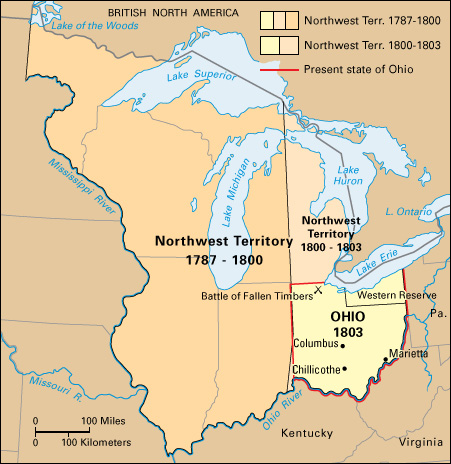
The Louisiana Purchase in 1803 gave Ohio settlers a river outlet for their products. They could ship goods down the Mississippi River and through the port of New Orleans. A thriving river trade with New Orleans soon developed. The first steamboat to travel the Ohio River was the New Orleans, a wood-burning side-wheeler. It first went down the river in 1811.
Ohio took an active part in the War of 1812 (1812-1815). Commodore Oliver H. Perry sailed from Put-in-Bay at South Bass Island off the Ohio shore to battle a British fleet on Sept. 10, 1813. Perry won an important naval victory in this Battle of Lake Erie (see Perry, Oliver H.). After the war, thousands of people moved to Ohio from the eastern states. Many came from New England, New York, and Pennsylvania. Immigrants arrived from the United Kingdom and Germany.
In 1818, the steamboat Walk-in-the-Water became the first steamboat on Lake Erie. It demonstrated the practical use of the Great Lakes as a waterway to the West. The Erie Canal across New York from Lake Erie opened in 1825. The Ohio and Erie Canal, joining Cleveland and Portsmouth, was completed in 1832. The Miami and Erie Canal, connecting Toledo and Cincinnati, was completed in 1845. These canals served as busy trade routes for more than 25 years. But the coming of the railroads reduced canal traffic. Ohio canals and railroads brought increased prosperity, and many mills and factories were built between 1830 and 1860.
An old border dispute between Ohio and the Territory of Michigan flared up in 1835 and led to the “Toledo War.” Before any actual fighting broke out, President Andrew Jackson sent agents to Toledo to persuade the governors of Ohio and Michigan to accept a truce. In 1836, Congress awarded the disputed area, about 520 square miles (1,350 square kilometers) along Lake Erie, to Ohio. In 1841, William Henry Harrison of North Bend became the ninth president.
The Civil War.
During the years before the American Civil War (1861-1865), many Ohioans had strong feelings on the question of slavery. Many abolitionists (Black and white people opposed to slavery) lived throughout Ohio. They helped enslaved people who had escaped across the Ohio River on their flight to Canada (see Underground railroad). Most of Ohio’s Southern sympathizers lived in the southern and north-central parts of the state. In 1862, Clement L. Vallandigham of Dayton became leader of the Peace Democrats Party, which opposed President Abraham Lincoln’s administration. Vallandigham and other Southern sympathizers were known as Copperheads. 
Famous Civil War commanders born in Ohio included Ulysses S. Grant and William T. Sherman. Ohio supplied about 345,000 men to the Union Army. This was more than the total quotas requested by 10 presidential calls for soldiers from the state. In 1863, Confederate cavalrymen known as Morgan’s Raiders crossed into Ohio and brought Civil War fighting to its northernmost point. Led by General John Hunt Morgan, they were captured in Columbiana County. Morgan later escaped and returned to the South. See Morgan, John Hunt.
Ohio’s industrial centers grew rapidly after the Civil War. Many workers from other countries settled in the state. The shipping of coal, iron ore, and other bulk goods on Lake Erie increased. Farming continued to be a leading industry, but Ohio also developed into a top manufacturing state. In 1869, the Cincinnati Red Stockings (now Reds) became the first all-professional baseball team. Benjamin F. Goodrich began manufacturing rubber products in Akron in 1870. 
Five Ohio-born presidents, all Republicans, were elected during the 1800’s. They were Ulysses S. Grant, Rutherford B. Hayes, James A. Garfield, Benjamin Harrison, and William McKinley. President William Henry Harrison of Ohio was born in Virginia.
The early 1900’s.
Ohio’s government was torn by scandal and corruption during the late 1800’s. Marcus A. “Mark” Hanna, political boss of Cleveland, and George B. Cox, boss of Cincinnati, both Republicans, dominated state politics. Around 1900, Mayors Samuel Jones of Toledo and Tom Johnson of Cleveland led influential movements to reform city governments. William Howard Taft of Cincinnati became the 27th president of the United States in 1909. 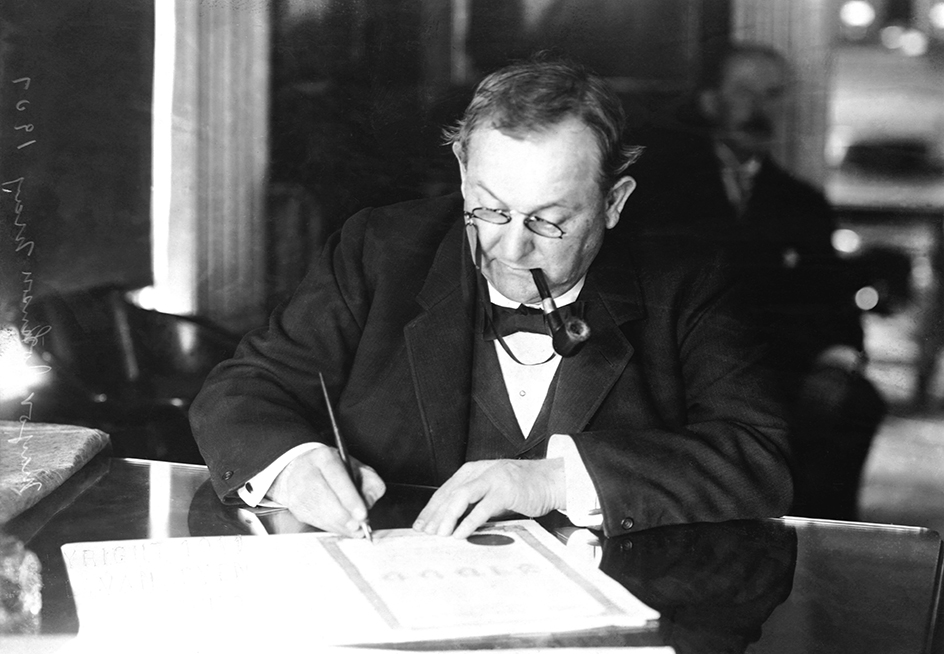
Ohio suffered the worst floods in its history during the spring of 1913. About 350 people lost their lives after rivers overflowed their banks, and damage totaled about $100 million. Most of the destruction occurred in the Miami River Valley, especially at Dayton. In 1914, the state legislature passed the Conservancy Act, the first legislation of its kind in the United States. The chief purpose of the act was to permit the establishment of flood-control districts based on entire river systems. Many flood-control dams and reservoirs were built under the Conservancy Act, including those completed by 1922 in the Miami River Valley. The federal government also built about 20 flood-control dams in Ohio.
After the United States entered World War I in 1917, the state produced vast supplies of war materials. Newton D. Baker of Cleveland served as secretary of war in President Woodrow Wilson’s wartime Cabinet.
Between world wars.
In 1921, Warren G. Harding of Marion became the 29th president. His Democratic opponent was Governor James M. Cox of Dayton. The 1920’s were prosperous years in Ohio, because of continued industrial development. Cincinnati, Cleveland, Dayton, Toledo, and other industrial cities expanded rapidly. Many nearby farms disappeared as the cities grew. The Great Depression that began in 1929 hit these cities hardest in Ohio. Thousands of workers lost their jobs as factories closed. Many farmers lost their land when farm prices dropped sharply.
Government funds and federal agencies such as the Works Progress Administration (WPA), later called Work Projects Administration, helped Ohio recover from the Depression during the 1930’s. In 1934, work began on the Muskingum River Valley flood-control project. This project came to national attention in 1937, when most of the dams withstood heavy floodwaters of the Ohio River. It was completed in 1938. Robert A. Taft, who became one of the most powerful U.S. Senators, began his first term as Republican senator from Ohio in 1939.
The mid-1900’s.
During World War II (1939-1945), Ohio produced aircraft, ships, and weapons. It also contributed steel, tires, and materials to the war effort. The armed services established a number of training centers in the state. During the 1950’s, the Atomic Energy Commission (AEC) built several installations in Ohio. They included the Portsmouth Area Project in Pike County, which produced uranium-235 for use in nuclear reactors. In 1955, the 241-mile (388-kilometer) Ohio Turnpike across northern Ohio opened. Since 1958, the National Aeronautics and Space Administration (NASA) has operated the John H. Glenn Research Center at Lewis Field in Cleveland. Scientists there conduct research on space propulsion systems.
Ohio’s industrial growth moved forward rapidly during the 1960’s. In 1963, the state launched a giant economic development program to attract more industry. Industrial expansion included new aluminum plants and chemical factories in cities in a region along the Ohio River that offered cheap, coal-generated power.
Ohio also entered international trade. Eight Ohio cities on Lake Erie—Ashtabula, Cleveland, Conneaut, Fairport, Huron, Lorain, Sandusky, and Toledo—became ports of the St. Lawrence Seaway, which opened in 1959. By 1970, Ohio ranked fourth among the states in the value of goods exported annually.
Several significant changes occurred in state government. In 1959, Ohio voters increased the terms of the governor and other elected executive officials from two to four years. The Supreme Court of the United States ruled in 1964 that Ohio must reapportion (redivide) its House of Representatives to provide more equal representation based on population. The state legislature drew up a reapportionment plan for both the House and Senate. The voters approved the plan in 1967.
Recent developments.
The state legislature enacted an income tax in 1971 to help pay for the rising costs of education and other state priorities. In 1973, voters approved an amendment to the state constitution permitting a state lottery to help fund public schools. Income taxes were increased in the early 1980’s to help provide funding for public schools and the state-supported university system, and to support other state public services. In the 1997 case DeRolph v. State of Ohio, the Ohio Supreme Court ruled that the school funding system was unconstitutional. The decision created controversy that continued into the 2000’s.
Changes in the cost and availability of energy resources have created problems for Ohioans. In the mid-1970’s, fuel shortages caused an increase in fuel prices and a decrease in industrial production. During a severe winter in 1977, a shortage of natural gas forced many of the state’s factories, offices, and schools to close temporarily.
In the mid-1980’s, however, abundant natural gas and cheaper petroleum gave a boost to many of Ohio’s important manufacturing industries, including the production of automobiles and chemicals. The state also funded the development of technologies to reduce the high-sulfur content of Ohio’s coal. The goal was to make the coal meet environmental standards, thus increasing its use. Coal remained the main source of Ohio’s electric power for decades, though its use began to decline during the 2000’s.
The pollution of Lake Erie and of Ohio’s rivers has been a serious problem for the state. Since the 1970’s, federal and state antipollution laws and controls have helped clean up Lake Erie and state rivers for both commercial fishing and recreation. Further projects, including efforts to control pollution and invasive species in Lake Erie, continued through the early decades of the 2000’s.
Since the late 1900’s, many Ohio manufacturers, especially the steel industry, have struggled to complete with foreign companies. Some of Ohio’s industries have moved to states with warmer climates and cheaper labor. Periodic declines in prices for crops and livestock have resulted in lower incomes for farmers. The state’s strong education, insurance, and health care sectors, along with investments in high-technology industries, helped stabilize Ohio’s economy in the early 2000’s. Beginning in 2020, the COVID-19 pandemic led to major economic and social disruptions in Ohio and around the world.
